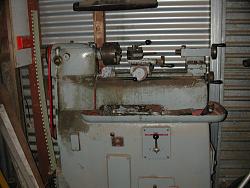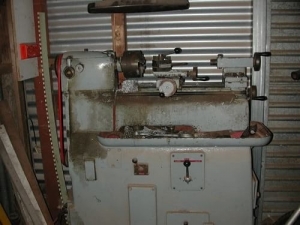I mentioned in my intro that I'm into restoring old machine tools.
Here's one of my first ones and how I came to buy it and learn about machining.....
In about 1974 I was building my first house and picked up a trailerload of gravel at a local sand and soil yard after a really heavy downpour that washed our driveway away.
Looking around the sodden yard, I spotted what looked like a headstock sticking out of a heap of muddy sand. I asked if there was a lathe buried there and the young guy loading my trailer confirmed it was. "Dad bought a small lathe a few decades ago, never got it to work and put it up there out of the way. It got covered over the years and the rain washed the top out". I asked if he wanted to sell it and he offered it to me for either $10 or $20 - I can't recall. Naturally I agreed and he dug it out with the loader. It was a small but very heavy lathe with integral cast base, but no tailstock or saddle. It had a turret (didn't know what that was) instead.
So I went home and emptied the trailer in the driveway and went back.
After loading the heavy lump (completely filled with mud) onto the trailer, the father of the loader driver came over and said he still had a box of collets and bits in the shed. If I wanted those I could have them. I didn't know what collets were and thanked him after loading the box of bits (some marked "Hardinge" - a meaningless name to me back then) in the boot.
After spending nearly a year (!) cleaning the poor thing out - with wirebrushes, screwdrivers and pressure washer, I took everything apart - some bits with great difficulties.
Since I had no idea how to really use a lathe - especially one with a fitting (turret) that I'd never seen before and lots of bits missing everywhere (e.g. the gearbox was empty, the lots of things were well and truly stuffed or useless: the integral 3-phase motor rusted into a solid lump of iron and copper, the cooling pump completely worn out and the headstock spindle worn badly too.
So in 1975 I enrolled in a Hobby Machining Course at the local TAFE (tech college) which ran for another 4 years (before it folded) once a week for 3 hours.
I got some initial tuition and then took my lathe bed there to rebuild along the lines of a Myford ML10.
The teacher helped me with this undertaking with lots of supervision, advice and set-ups.
I got hold of a large jagged lump of cast iron scrap about 2" thick and a triangular shape about 3'x1'. I then set about fabricating a power hacksaw to cut this into suitable sized pieces to make a saddle, apron, cross slide, top slide base and top slide, tailstock base and handwheels. The longest cut took 3 1/2 hrs to complete in the poor power hacksaw.
The lathe was operationally but without threading or powerfeed capacity by 1979. It has a handwheel on the leadscrew at the tailstock end. I fabricated a tailstock by welding a number of thick steel plates and a piece of 1 1/2" square steel bar. I stress relieved in our open fireplace by building a fire around it and keeping it glowing red for several hrs and letting it cool in the fire overnight.
It then was machined at TAFE, barrel made etc.
I've been using this lathe ever since - and it now needs a rebuild again.
Only a few years ago I found out what it originally was: a precision turret lathe from the late '30s most likely, a CVA Model 75 Precision Capstan lathe.
Here are some photos and a description of it - near the bottom of the page (the colour photos).
Today it looks like this:
Cheers,
Joe



 LinkBack URL
LinkBack URL About LinkBacks
About LinkBacks



 Reply With Quote
Reply With Quote


Bookmarks